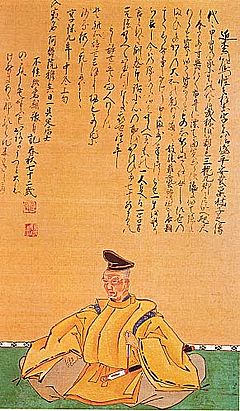Chikamatsu Monzaemon facts for kids
Quick facts for kids
Chikamatsu Monzaemon
|
|
|---|---|
 |
|
| Born |
Sugimori Nobumori
1653 |
| Died | January 6, 1724 (aged 70–71) |
Chikamatsu Monzaemon (近松 門左衛門 (real name Sugimori Nobumori, 杉森 信盛, 1653 – 6 January 1725)) was a famous Japanese writer of plays. He wrote for two main types of theater: jōruri (puppet theater, later called bunraku) and kabuki (live-actor drama). Many people think he was the greatest Japanese playwright ever.
Chikamatsu wrote about 70 historical plays and 24 plays about everyday life. His plays about daily life are considered his best work today. One of his historical plays, The Battles of Coxinga (1715), is still very popular.
Contents
Biography
Chikamatsu Monzaemon was born Sugimori Nobumori in 1653. He came from a samurai family. A samurai was a warrior in old Japan. There are different ideas about where he was born. Most people believe he was born in Echizen Province, which is now Fukui Prefecture.
His father, Sugimori Nobuyoshi, was a doctor for a powerful lord called a daimyō in Echizen. In those days, doctors who worked for daimyōs had the same rank as samurai. Chikamatsu's younger brother also became a doctor. Chikamatsu even wrote a book about health care himself.
However, Chikamatsu's father lost his job. This meant he became a rōnin, which was a samurai without a master. When Chikamatsu was a teenager, he moved to Kyoto with his father. For a few years, he worked as a page for a noble family. Not much else is known about this time in his life.
In 1671, he published his first known writing, a short poem called a haiku. Later, he was connected to the Gonshō-ji temple. This temple's name, "Chikamatsu," is thought to be where he got his pen name.
His Plays
Chikamatsu became known as a playwright in 1683. This was when his puppet play about the Soga brothers, called The Soga Successors, was performed in Kyoto. People believe this was his first play.
He also wrote plays for the kabuki theater between 1684 and 1695. Most of these plays were written for a very famous actor named Sakata Tōjūrō. After 1695, Chikamatsu wrote mostly Kabuki plays until 1705. Then, he suddenly stopped writing Kabuki plays almost completely.
No one knows exactly why he stopped. Maybe he found puppets easier to work with than actors. Or perhaps he felt Kabuki wasn't worth writing for anymore since Tōjūrō was going to retire. Another idea is that puppet theater was becoming very popular, which meant more money for playwrights.
In 1705, Chikamatsu became a "Staff Playwright." Around 1705 or 1706, he moved from Kyoto to Osaka. Puppet theater was even more popular there. Chikamatsu's fame grew a lot with his plays about everyday life. His play The Battles of Coxinga was a huge success in 1715.
Later, people started to prefer more exciting and sometimes rougher plays. Chikamatsu's plays were used less often, and even the music for many of them was lost. He passed away on January 6, 1725, in either Amagasaki or Osaka.
In 1706, he wrote a puppet play called Goban Taiheiki. This play was based on the story of the Forty-seven rōnin. This story later became the much more famous play Chūshingura.
Chikamatsu was the first Japanese playwright known to write plays without also acting in them. We know for sure that he wrote 130 plays. Another 15 plays, mostly early Kabuki works, are also thought to be written by him.
Quotations
- "Art is something that lies in the slender margin between the real and the unreal." — Chikamatsu Monzaemon, Naniwa Miyage
Adaptations of His Work
Chikamatsu's stories have been made into movies and even an opera!
Selected film adaptations
- Kenji Mizoguchi's black and white film Chikamatsu Monogatari (1954) is based on Chikamatsu's play Daikyōji Mukashi Goyomi. It's also known as "The Crucified Lovers."
- Masahiro Shinoda's film Shinjū: Ten no Amijima (1969) uses special movie techniques inspired by bunraku puppet theater.
Opera
- Japanese composer Mayako Kubo created an opera called Osan. It was first performed in Tokyo in 2005.
Major Works
Here are some of Chikamatsu's important plays:
Jōruri (Puppet Plays)
- Kagekiyo Victorious (Shusse kagekiyo) (1685)
- The Courier for Hell (Meido no hikyaku) (1711)
- The Battles of Coxinga (Kokusen'ya kassen) (1715)
- The Uprooted Pine (Nebiki no Kadomatsu) (1718)
Critical work
- Naniwa Miyage (1738): This book was written by a friend of Chikamatsu. It shares many of Chikamatsu's thoughts about the art of puppet theater.
Images for kids
See also
 In Spanish: Chikamatsu Monzaemon para niños
In Spanish: Chikamatsu Monzaemon para niños
- Japanese literature
- List of Japanese authors
- Gagaku



